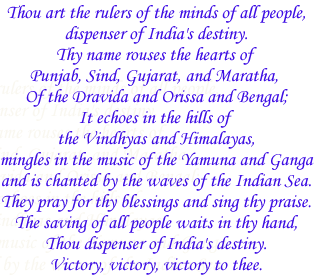



You have to grow from the inside out. None can teach you, none can make you spiritual. There is no other teacher but your own soul.

 Jai Hind
Jai Hind
 Rabindranath Tagore was the youngest son of Debendranath Tagore, a leader of the Brahmo Samaj, which was a new religious sect in nineteenth-century Bengal and which attempted a revival of the ultimate monistic basis of Hinduism as laid down in the Upanishads. He was educated at home; and although at seventeen he was sent to England for formal schooling, he did not finish his studies there. In his mature years, in addition to his many-sided literary activities, he managed the family estates, a project which brought him into close touch with common humanity and increased his interest in social reforms. He also started an experimental school at Shantiniketan where he tried his Upanishadic ideals of education. From time to time he participated in the Indian nationalist movement, though in his own non-sentimental and visionary way; and Gandhi, the political father of modern India, was his devoted friend. In 1913 He became the first Asian to receive Nobel Prize for literature. Tagore was knighted by the ruling British Government in 1915, but within a few years he resigned the honour as a protest against British policies in India.
Rabindranath Tagore was the youngest son of Debendranath Tagore, a leader of the Brahmo Samaj, which was a new religious sect in nineteenth-century Bengal and which attempted a revival of the ultimate monistic basis of Hinduism as laid down in the Upanishads. He was educated at home; and although at seventeen he was sent to England for formal schooling, he did not finish his studies there. In his mature years, in addition to his many-sided literary activities, he managed the family estates, a project which brought him into close touch with common humanity and increased his interest in social reforms. He also started an experimental school at Shantiniketan where he tried his Upanishadic ideals of education. From time to time he participated in the Indian nationalist movement, though in his own non-sentimental and visionary way; and Gandhi, the political father of modern India, was his devoted friend. In 1913 He became the first Asian to receive Nobel Prize for literature. Tagore was knighted by the ruling British Government in 1915, but within a few years he resigned the honour as a protest against British policies in India.

 Baba Amte Murlidhar Devidas Amte was born on December 24, 1914 in Hingaighat, Wardha. "He came to be known as Baba not because he is a saint or any such thing, but because his parents addressed him by that name," reveals Sadhanatai, his wife. The seeds of social activism were sown early. Belonging to a family of brahmin jagirdars, regardless of his parents's disapproval, Baba Amte often ate with servants and played with lower caste children. As a nine-year-old, he was so moved by the sight of a blind beggar that he dropped a handful of silver coins in his bowl.
Baba Amte Murlidhar Devidas Amte was born on December 24, 1914 in Hingaighat, Wardha. "He came to be known as Baba not because he is a saint or any such thing, but because his parents addressed him by that name," reveals Sadhanatai, his wife. The seeds of social activism were sown early. Belonging to a family of brahmin jagirdars, regardless of his parents's disapproval, Baba Amte often ate with servants and played with lower caste children. As a nine-year-old, he was so moved by the sight of a blind beggar that he dropped a handful of silver coins in his bowl.


 Mother Teresa was born Agnes Gonxha Bojaxhiu in Skopje, Macedonia, on August 26, 1910. Her family was of Albanian descent. At the age of twelve, she felt strongly the call of God. She knew she had to be a missionary to spread the love of Christ. At the age of eighteen she left her parental home in Skopje and joined the Sisters of Loreto, an Irish community of nuns with missions in India. After a few months' training in Dublin she was sent to India, where on May 24, 1931, she took her initial vows as a nun. From 1931 to 1948 Mother Teresa taught at St. Mary's High School in Calcutta, but the suffering and poverty she glimpsed outside the convent walls made such a deep impression on her that in 1948 she received permission from her superiors to leave the convent school and devote herself to working among the poorest of the poor in the slums of Calcutta. Although she had no funds, she depended on Divine Providence, and started an open-air school for slum children. Soon she was joined by voluntary helpers, and financial support was also forthcoming. This made it possible for her to extend the scope of her work.
Mother Teresa was born Agnes Gonxha Bojaxhiu in Skopje, Macedonia, on August 26, 1910. Her family was of Albanian descent. At the age of twelve, she felt strongly the call of God. She knew she had to be a missionary to spread the love of Christ. At the age of eighteen she left her parental home in Skopje and joined the Sisters of Loreto, an Irish community of nuns with missions in India. After a few months' training in Dublin she was sent to India, where on May 24, 1931, she took her initial vows as a nun. From 1931 to 1948 Mother Teresa taught at St. Mary's High School in Calcutta, but the suffering and poverty she glimpsed outside the convent walls made such a deep impression on her that in 1948 she received permission from her superiors to leave the convent school and devote herself to working among the poorest of the poor in the slums of Calcutta. Although she had no funds, she depended on Divine Providence, and started an open-air school for slum children. Soon she was joined by voluntary helpers, and financial support was also forthcoming. This made it possible for her to extend the scope of her work.
A spiritual genius of commanding intellect and power, Vivekananda crammed immense labor and achievement into his short life, 1863-1902. Born in the Datta family of
At the same time, vehement in his desire to know the truth about God, he questioned people of holy reputation, asking them if they had seen God. He found such a person in Sri Ramakrishna, who became his master, allayed his doubts, gave him God vision, and transformed him into sage and prophet with authority to teach.
After Sri Ramakrishna's death, Vivekananda renounced the world and criss-crossed
For three years he spread the Vedanta philosophy and religion in
